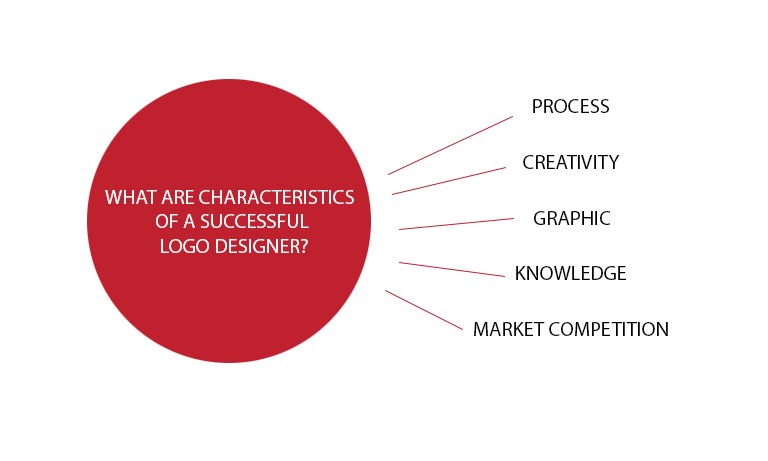Logo design is crucial in introducing your brand identity over the internet, where millions of people will come through your business. The best logo designers are pressured to create a meaningful logo associated with the business name and functions.
What is the process of a Successful Logo?
The logo design process starts with rough sketches, multiple drafts, the final design, and touch-ups. A designer puts a lot of energy, skills, and thought into a logo design. Although the process is superficial, specific interpersonal characteristics and abilities are required to become a successful logo designer.
Below are a few characteristics of a successful logo designer, from which you can judge your designer if you are using a professional logo design service.
Creative Intelligence of Logo Designers:
Crystallized intelligence, our ability to retrieve acquired knowledge and apply it in situations, is contrary to creative intelligence. Creative intelligence is the ability to generate and explore new ideas, provide novel solutions, design, graphic meaning, and much more. The principles of logo design can be learned and polished, but a person with creative intelligence has leverage over any individual with expertise.
You can spot a logo designer’s creative intelligence through their portfolio. Several high-end agencies hire successful logo designers with creative intelligence to best serve their customers.
Graphic Message:
One trait that makes every artist stand out is the ability to generate a graphic message using multiple pictures, shapes, and colors combined into a style. Similarly, logo designing is much about portraying the visual message, product, or function of the company through shapes, pictures, typography, and colors incorporated in the logo. For successful logo designers, the ability to generate a graphic message is their biggest asset. Graphic messages are emotionally solid and attractive to the audience. Graphic messages can be essential in business with animal cruelty-free, environment-friendly, and organic production products.
Basic Knowledge of Typography:
Creative intelligence may not be a skill you excel at compared to someone natural at it. However, specific skills can take the logo designer to the top of the game. One of these skills is a basic knowledge of typography.
Typography has four primary categories, but you can explore thousands of fonts for a logo design. Typography can pretty much make or break your logo. A logo designer’s basic knowledge of typography means they know the thumb rule of which logo belongs to which genre and can match a font with the business tone.
As a businessman, you wouldn’t want your beauty products company to have a logo font similar to that of a Halloween decorations company. So, next time you hire a logo designer, ask about their expertise in typography.
Market Competition Awareness:
Imagine a designer providing designs based on market trends that have come and gone. Deal breaker, right? Entrepreneurship is a booming industry with new ideas and modifications to existing trends. It’s creative and exciting, but with the new chain of ideas, a designer must keep up with the market. Every day, top designers are experimenting with new horizons.
Market competition awareness means the designer knows which logo styles are trending, how long they will last, and whether the trend should be followed.
Adaptability:
Social media’s creative aspect and the tangible market are interlinked and ever-changing. A new trend circling social media marketing affects the market, and a trend in the market affects social media marketing.
For example, a movement to demolish beauty standards such as fair skin or slim body means any company with a logo incorporating slim body and fair skin will have to change its brand identity before the audience boycotts the product.
The decision to change brand identity belongs to the business, but the work to generate a new identity belongs to the designer. A successful logo designer is capable of reinventing at every stage. A logo designer should be able to incorporate business messages while avoiding the stereotypes in the logo design.
Digital Resources:
“The slow and steady wins the race.” Yes, but no. The proverb is not suitable for the design industry. The design market has advanced from Photoshop and Illustrator and continuously introduces new digital resources and software for designers to explore new techniques. While the best logo designers can efficiently create with mainstream software, a successful designer can properly apply digital resources to projects.
The better the application of digital resources, the better the outcome.
Eye to Detail:
We all have felt satisfied when looking at an organized yet creative logo design, and we praise it with the term “eye to detail” or “attention to detail” skill. Creative intelligence revolves around genes, but eye-to-detail ability can be learned. A successful logo designer has an eye for detail and achieves thoroughness and accuracy in the business logo. A designer who pays attention to detail can generate a more organized, clean, and productive logo, a few essentials for a straightforward business visual and message. Eye to detail is an important trait that successful designers use when designing logos for a cooperative and technical business that requires a severe tone.
Follow Brief:
Creative skills, thumb rules, and knowledge about logo design are essential for an exceptional logo design, but customer reviews are equally important. Eight of ten successful logo designers provide outstanding customer services by following the brief.
Every customer wants the designer to be creative according to the company’s guidelines. A successful designer should have the patience to follow the brief. To conclude this article, a successful designer possesses the skills of creativity, technicality, interpersonal communication, and patience to follow customers’ briefs.
